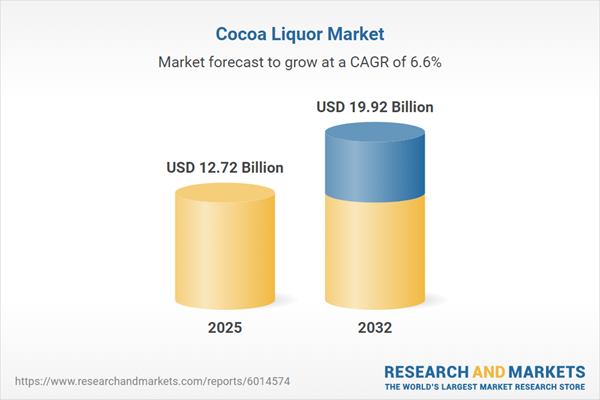Speak directly to the analyst to clarify any post sales queries you may have.
The cocoa liquor market is a pivotal segment in food and beverage supply chains, where leaders must navigate evolving procurement methods, technology applications, and regulatory frameworks to drive resilient, differentiated operations across dynamic global markets.
Cocoa Liquor Market Snapshot and Growth Outlook
In 2024, the cocoa liquor market is valued at USD 11.94 billion and is anticipated to rise to USD 12.72 billion by 2025, demonstrating a compound annual growth rate (CAGR) of 6.60%. By 2032, it is forecasted to reach USD 19.92 billion. This upward trend is driven by increasing demand for genuine chocolate experiences, improvements in ingredient formulation, and prioritization of transparency in both sourcing and quality management. Ethical procurement and quality-focused sourcing are becoming key levers for competitive positioning. The sector influences procurement and operational strategies across the food, beverage, and confectionery landscape worldwide.
Cocoa Liquor Market Scope & Segmentation
- Applications: Cocoa liquor is utilized in the development of chocolate, baked products, beverage applications, as well as diverse confectionery items like bars and candies. Its broad applicability enables cross-category product innovation and supports evolving consumer taste preferences.
- Product Types: Available as mass (cake or flake), paste, and sweetened or unsweetened powder, cocoa liquor forms offer R&D and production teams flexibility to develop and optimize recipes for varying market segments.
- Bean Types: The market incorporates Criollo, Forastero, and Trinitario beans, allowing producers to tailor flavor profiles and quality distinctions, which can be aligned with both premium and volume-targeted offerings.
- Process Segments: Manufacturing processes include both natural and alkalized varieties, enabling precise control of color and taste to satisfy regional consumer expectations and brand specifications.
- Distribution Channels: B2B transactions are driven via manufacturers and wholesalers, while additional reach is achieved through supermarket, hypermarket, and online retail options, supporting both bulk procurement and end-user availability.
- Regional Markets: The cocoa liquor market extends across the Americas, Europe, Asia-Pacific, and the Middle East & Africa, with accelerated transformation in China, India, Southeast Asia, Japan, Korea, and Australia as local supply chain strategies adapt to emerging requirements.
- Key Companies Analyzed: Leading firms—Barry Callebaut AG, Cargill, Olam International, ECOM Agroindustrial, Blommer Chocolate, Fuji Oil, Guan Chong, ADM, AAK AB, and ED&F Man Group—differentiate through sourcing innovation, efficient distribution, and robust sustainability initiatives.
Key Takeaways for Senior Decision-Makers
- Digital tracking technologies are being adopted to improve supply chain visibility, enhancing procurement decisions and enabling consistent quality management from sourcing to delivery.
- Market interest in premium and single-origin cocoa liquor has intensified, reshaping supplier evaluation processes through increased certification and transparency requirements.
- Sustainability criteria and traceability standards are pivotal in supplier selection, supporting risk mitigation and longer-term partnership development.
- Product line expansion and operational adjustments help manufacturers comply with regulatory changes, while also meeting higher consumer expectations for ingredient origin and processing practices.
- Logistics optimizations, such as just-in-time delivery, support adaptive responses to market fluctuations and mitigate supply chain interruptions by aligning inventory with regional demand patterns.
Tariff Impact: Navigating United States Market Changes
Changes to United States tariff structures are prompting businesses to diversify supplier bases and shift processing operations closer to consumer centers. Organizations are prioritizing revisions to supplier agreements and product specifications to protect margins and maintain procurement stability amid evolving regulations.
Methodology & Data Sources
This report integrates extensive secondary research, interviews with senior executives, and targeted supply chain analysis. Peer benchmarking, laboratory product testing, and professional sensorial review contribute actionable insights for strategic direction within the cocoa liquor sector.
Why This Report Matters
- Offers forward-looking perspectives on shifts in cocoa liquor sourcing, supplier strategies, and digital technology adoption to enable robust operational planning and competitive agility.
- Presents segmented data and analytics to guide R&D investments and facilitate effective, data-driven decisions for globally distributed teams.
- Equips procurement leaders with comprehensive frameworks to inform supplier selection and foster resilient supply strategies in a changing market.
Conclusion
Cocoa liquor market leaders that proactively align with supply and technology evolutions will strengthen compliance, drive operational quality, and secure continuity as industry dynamics advance.
Additional Product Information:
- Purchase of this report includes 1 year online access with quarterly updates.
- This report can be updated on request. Please contact our Customer Experience team using the Ask a Question widget on our website.
Table of Contents
3. Executive Summary
4. Market Overview
7. Cumulative Impact of Artificial Intelligence 2025
Companies Mentioned
The companies profiled in this Cocoa Liquor market report include:- Barry Callebaut AG
- Cargill, Incorporated
- Olam International Limited
- ECOM Agroindustrial Corp. Ltd.
- Blommer Chocolate Company, Inc.
- Fuji Oil Holdings Inc.
- Guan Chong Cocoa Manufacturer Sdn. Bhd.
- Archer Daniels Midland Company
- AAK AB
- ED&F Man Group Limited
Table Information
| Report Attribute | Details |
|---|---|
| No. of Pages | 180 |
| Published | November 2025 |
| Forecast Period | 2025 - 2032 |
| Estimated Market Value ( USD | $ 12.72 Billion |
| Forecasted Market Value ( USD | $ 19.92 Billion |
| Compound Annual Growth Rate | 6.6% |
| Regions Covered | Global |
| No. of Companies Mentioned | 11 |









